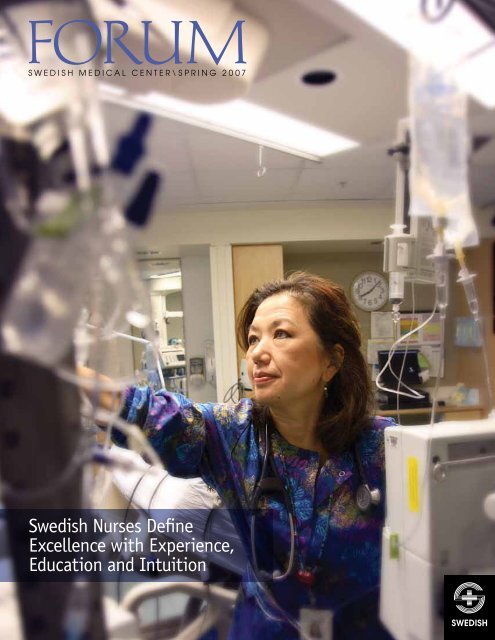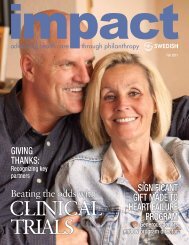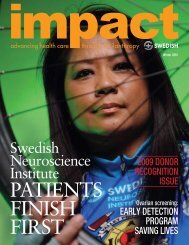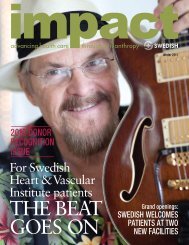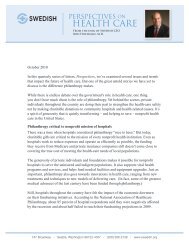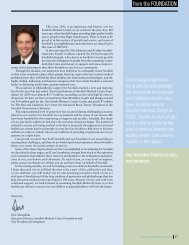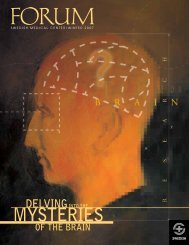Spring Edition - Swedish Foundation
Spring Edition - Swedish Foundation
Spring Edition - Swedish Foundation
- No tags were found...
Create successful ePaper yourself
Turn your PDF publications into a flip-book with our unique Google optimized e-Paper software.
S W E D I S H M E D I C A L C E N T E R \ S P R I N G 2 0 0 7<strong>Swedish</strong> Nurses DefineExcellence with Experience,Education and Intuition
O N T H E C O V E RMaria Maxino, C.C.R.N., reviews vital patient-monitoring informationin the Intensive Care Unit on <strong>Swedish</strong>’s First Hill Campus.Like Maria, many of our more than 2,000 nurses deliver compassionateinpatient care. Others work in outpatient clinics, manage operating rooms,work directly with surgeons and other physicians, make home health visitsand provide education and support to other nurses in outlying areas. Stillothers serve in key leadership roles throughout the organization.At <strong>Swedish</strong>, various educational programs and scholarshipshelp ensure that the best possible nursing care will always be availablefor all <strong>Swedish</strong> patients.For information on how you can help, contact the<strong>Swedish</strong> Medical Center <strong>Foundation</strong> at 206-386-2738.
During my first few weeks as president and CEO of <strong>Swedish</strong>, I havebeen getting to know the organization by visiting as many differentareas as I can – from our nursing units and operating rooms to ourphysician clinics and emergency rooms. What an amazing place.Everywhere I turn, I meet people who take pride in their work and are justas passionate as I am about delivering quality health care.Though I have spent much of my career on the East Coast, I have admired <strong>Swedish</strong> for some time.Every day, I see more reasons why <strong>Swedish</strong> is respected nationally as a leader and innovator in healthcare, and I am thrilled to be a part of it.At the core of <strong>Swedish</strong> are our nurses. Their professionalism, expertise, skill and compassion makea difference in the lives of others on a daily basis. As we celebrate National Nurses Week this May,I encourage you to read the feature article in this issue of FORUM to learn more about the contributionsour nurses make.Watching all of our employees and physicians in action and seeing our innovative treatments andtechnologies at work, I immediately recognize the vital role <strong>Swedish</strong> plays in the community. I amencouraged that many others recognize that as well and give so generously to support our nonprofitmission and make this important work possible.I had an opportunity to see the generosity of our donors first hand at Celebrate <strong>Swedish</strong> – ourannual gala auction, which generated a record-breaking $3.4 million. Special thanks to Bill and CherylGossman who not only chaired this year’s event but made a personal gift of $1 million to help createthe Gossman Center for Advanced Pediatric and Perinatal Simulation. It was fun to experience all theenthusiasm and commitment of that evening. I see tremendous potential to develop an even strongerculture of philanthropy at <strong>Swedish</strong>.My wife Nancy and I love the Northwest and feel very fortunate to be in this beautiful area. We feeleven more fortunate to be part of this impressive health-care system. I look forward to talking withyou in the near future about how you can continue to support <strong>Swedish</strong> and make a difference in thelives of our patients.All the best,Rod Hochman, M.D.President and Chief Executive Officer
C A P S U L E SF O R U MSPRING 2007Volume 21, Issue IIT a b l e o f C o n t e n t sMelissa TizonDirector, CommunicationsEditor:Janet SimmelinkDesigner:Mike DurrantProduction Team:Amanda HolmNatalie KozimorFeature Writer:Janice KennedyContributing Writer:Scott McRaeFeature Photographer:Doug OgleContributing Photographers:Matt Brashears<strong>Swedish</strong> Medical Photography and VideoSweney ProductionsBen VanHoutenC A P S U L E SWork Begins on New Orthopedic Facility.................................... 3<strong>Swedish</strong> First to Offer Calypso® Technology................................ 4<strong>Swedish</strong> Heart & Vascular InstituteLaunches iheartswedish.org............................................................ 4High-Tech Neuro Operating Rooms Open.................................. 5Providence Campus Renamed Cherry Hill.................................. 5F E A T U R E<strong>Swedish</strong> Nurses Define Excellence with Experience,Education and Intuition................................................................... 6F O U N D A T I O N N E W SOne Million Dollar Gift to LaunchSimulation Training Center.......................................................... 16Celebrate <strong>Swedish</strong> 2007 Breaks Records..................................... 18Gifts to Support Child Life Services Program........................... 20Welcome to <strong>Swedish</strong> Medical Center’s FORUMmagazine. This publication is designed to provideyou with the latest information about <strong>Swedish</strong>services and events, health-care and medicaltopics, and the activities of the <strong>Swedish</strong> MedicalCenter <strong>Foundation</strong> and its supporters. FORUMis published as a community service by <strong>Swedish</strong>Medical Center. Any questions or commentsmay be addressed to Janet Simmelink, editor,<strong>Swedish</strong> Medical Center, 747 Broadway, Seattle,WA 98122-4307.Making an Impact on Patient Care –Yesterday, Today and Tomorrow.................................................. 202 F O R U M • S P R I N G 2 0 0 7
C A P S U L E SWork Begins on New Orthopedic Facility<strong>Swedish</strong>’s orthopedic program is thelargest in the region, with more than50 physicians who perform more than6,400 procedures each year. And with thepopulation aging, the need for orthopediccare will continue to rise.To meet this need, <strong>Swedish</strong> brokeground in January on an all-new dedicatedOrthopedic Institute — a $130 millionfacility that will be the first of its kindin the Pacific Northwest. The 372,000-square-foot building, located on First Hillwill open in early summer 2008.The Orthopedic Institute — which hasbeen in planning for more than four years— was designed by a team that includedorthopedic surgeons, anesthesiologists,nurses, physical therapists, administrationand other staff. It will feature:• 84 new inpatient beds (56 to startwith and 28 to be added at afuture date)• 10 operating rooms• A dedicated sterile-processing area• A dedicated preadmissiontesting area• 15 flexible preoperation/recovery beds• 13 post-anesthesia care-unit beds• An outpatient pharmacy• Conference rooms• Two floors of orthopedic medicaloffice space• A caféIn addition to meeting the heath-careneeds of the community, the OrthopedicInstitute will meet a need at the First Hillcampus for replacement beds and operatingrooms. It also allows for consolidationof orthopedic services under one roof.“In this dedicated facility we’ll be ableto consolidate our orthopedic resourcesin a way that is efficient for patients,physicians and staff,” said <strong>Swedish</strong> ChiefOperating Officer Cal Knight, who overseesorthopedic services. “The projecthas also given us the ability to create atechnologically advanced facility thatwill allow <strong>Swedish</strong> to continue to provideworld-class orthopedic care well intothe future.”A view of the future <strong>Swedish</strong> Orthopedic Institute from the corner of Broadway and James Street.F O R U M • S P R I N G 2 0 0 73
C A P S U L E SCancer Care: <strong>Swedish</strong> First to Offer GPS for the BodyIn January, the <strong>Swedish</strong> Cancer Institute(SCI) became the first in world to usethe Calypso® 4D Localization System —or GPS for the Body® — to treat prostatecancer. This new technology pinpoints atumor’s exact location and continuouslymonitors its movement during radiationtreatment, preventing damage to healthytissue adjacent to the tumor.How Calypso worksTiny electromagnetic sensors, calledBeacon® transponders, are implanted inthe prostate prior to treatment. Duringradiation treatment, the Calypso Systemtracks the transponder positions andwarns clinicians when the prostate is notproperly aligned with the radiation beam.“This 4D monitoring technology is akey building block in the <strong>Swedish</strong> CancerInstitute’s commitment to providepatients access to a complementaryarray of leading-edgeradiation therapy deliveryoptions through the Center forAdvanced Targeted RadiationTherapies,” said Albert B.Einstein Jr., M.D., executivedirector of the SCI. “We’re honoredto be the first program inthe world to offer the CalypsoSystem to prostate cancerpatients.”The Calypso System received U.S.Food and Drug Administration approvalin August 2006 and was developedthrough the collaborative effort ofSeattle’s Calypso Medical Technologiesand the SCI.Pictured: A Beacon transponder. While this maincomponent of GPS for the Body may only be thesize of a grain of rice, its impact on the world ofcancer care is huge.Tour the <strong>Swedish</strong> Heart & Vascular Institute Online: iheartswedish.orgPhysicians and health-care consumersfrom the Northwest and beyond cannow take a comprehensive tour of thenewly remodeled and upgraded <strong>Swedish</strong>Heart & Vascular Institute (SHVI) in thecomfort of their offices or homes.iheartswedish.org is an interactive Website featuring multiple video and audioclips of SHVI physicians, procedures,equipment and facilities. It presents anengaging overview of key services andprograms at the SHVI.“The new Microsite allows us to offervital information about the institute tothe people who use our services,” saysHoward Lewis, M.D., executive directorof the SHVI. “It provides easy access forphysicians and the public and helps uscommunicate the highlights of our heartand vascular program.”iheartswedish.org features eight sectionsthat highlight:• Cardiovascular Imaging• Cardiac Surgery• Interventional Cardiology• Research & Education• Cardiovascular Wellness• Vascular & Endovascular• Electrophysiology• Partnerships & AffiliationsIncluded on the Microsite is a responsesystem that lets physicians make directcontact with SHVI specialists. The publiccan also request additional information,and there is a link to the main <strong>Swedish</strong>Web site: www.swedish.org.4 F O R U M • S P R I N G 2 0 0 7
C A P S U L E S<strong>Swedish</strong> Neuroscience Institute Opens New Clinical ComplexPatients who come to <strong>Swedish</strong> for neurologicalcare can rest assured theywill have access to the latest in treatmentsand technologies. The <strong>Swedish</strong>Neuroscience Institute (SNI) has alwaysbeen a leader in providing the best neurologicalcare, and the Institute is takingthis commitment to new heights with theopening of its $30 million clinical complexat the Cherry Hill campus.The new facility features four state-ofthe-artoperating rooms (O.R.s) whichwill be used for neurosurgical and neurointerventionalprocedures. The O.R.sintegrate sophisticated guidance andimaging systems in a way that is unique inthe country. Not only are various technologiesbuilt right into the O.R., but all theinformation a surgeon needs is integratedand centralized from multiple sourcesand displayed throughout the room.Specifically, the new integrated technologiesinclude:• GPS-like guidance systems builtinto every O.R. that help surgeonsnavigate in critical areas of the brainduring operationsStaff members prepare the new operating rooms for opening.• Intraoperative MRI and CT scannersand 3-D angiography that providevital images during surgery• Brain-mapping capabilities to identifyareas of critical brain functionthrough microelectrode recordings ofbrain tissue• Systems that allow all the informationavailable to the surgeon to beintegrated and displayed on ceilingmountedLCD screens for continuousaccess by the O.R. team, and transmittedoutside the O.R. for teachingpurposes or consultation withcolleaguesWith a growing emphasis on minimallyinvasive approaches to treatingbrain tumors, head trauma, stroke, spinaldisorders and chronic diseases such asParkinson’s, these high-tech O.R.s bettersupport physicians’ use of less-invasivetechnologies so that procedures can bedone with less risk — and patients can gohome as quickly as possible.Providence Campus Renamed Cherry Hill<strong>Swedish</strong> has officially renamed its Providence campus to<strong>Swedish</strong> Medical Center/Cherry Hill. The name changeis part of an agreement between <strong>Swedish</strong> and ProvidenceHealth System, the organization from which <strong>Swedish</strong> acquiredthe hospital seven years ago.Cherry Hill is a historic name for the neighborhoodsurrounding the hospital, located at 500-17th Ave. in Seattle.The Providence campus will now be known as<strong>Swedish</strong> Medical Center/Cherry Hill.F O R U M • S P R I N G 2 0 0 75
<strong>Swedish</strong> Nurses6F O R U M • S P R I N G 2 0 0 7
Define Excellencewith Experience,Education and IntuitionRecently, a patient was transferred from <strong>Swedish</strong>’s EmergencyRoom to the Intensive Care Unit (ICU). Although the woman,who was in her forties, had a fever, she was alert and did notseem seriously ill. She said, in fact, that she’d never been sickin her life. To the casual observer, it may have seemed puzzling why shewas in intensive care.But all Maria Maxino, C.C.R.N., had to dowas look at this patient to know she wouldsoon be in a fight for her life. Other nurseson the unit agreed, as did the medical director,and together they rapidly hooked up thepatient to intravenous fluids, medicationsand monitoring equipment.Despite this rapid response, the woman’svital signs soon deteriorated and her breathingbecame so labored she needed to beplaced on a ventilator – all as Maria, 53,thought might happen. When test resultsarrived, they pointed to toxic shock syndromecaused by a massive bacterial infectionthat was rapidly overwhelmingF O R U M • S P R I N G 2 0 0 77
the woman’s body. Without the quickintervention of the ICU staff, this patientwould not have survived the night. Weekslater, she was still hospitalized and strugglingto regain her health.How did Maria know that the patient,who seemed only slightly ill, was as sick asshe was and needed immediate help? It’sbecause, says Maria, “I’m a nurse.”That simple answer – “I’m a nurse”– doesn’t begin to explain the complex waysthat Maria and the more than 2,200 othernurses at <strong>Swedish</strong> Medical Center helppatients each day. Being a <strong>Swedish</strong> nurse caninclude saving a life one day and the nextmaking sure that same patient gets a reassuringsmile.<strong>Swedish</strong> nurses range in age from newgraduates to 30-year veterans. In additionto delivering inpatient acute care, theywork in outpatient clinics, manage operatingrooms, work directly with surgeons andother physicians, make home health visits,and provide education and support to othernurses in outlying areas. Many <strong>Swedish</strong>nurses manage the work of other nursesand health-care providers and make sureeach unit of the medical center delivers thebest patient care possible on any given day.The work of a nurse can be challenging,rewarding and exhausting. At <strong>Swedish</strong>,nurses are known for their excellencein patient care. Here are just a few of themany who provide that care every hour ofthe day, every day of the year at <strong>Swedish</strong>.Knowing What to Doand WhenWillem Rivera, R.N., is 38 and has beena nurse most of his adult life. On <strong>Swedish</strong>’sCardiac Telemetry Unit, Willem cares forpatients with conditions that require closemonitoring. They are often hooked up tomachines such the telemon, which can providecontinuous data on heart rhythms andrates, blood pressure and oxygen saturation.Willem has had advanced training in how tointerpret all this information and adjust thepatient’s care accordingly.But Willem is like Maria — and all goodnurses — in that he depends a lot on hisown “sense” of how patients are respondingMaria Maxino, C.C.R.N.8F O R U M • S P R I N G 2 0 0 7
Willem Rivera, R.N., and patientto their care. It’s a combination of experienceand education, he says, that tellshim when a patient’s condition is aboutto worsen. Nurses like Willem and Mariabegin a patient’s assessment as soon as theystep into a room. Is there food left on themeal tray? Does she seem alert to my voice?Are his eyes focusing on me? What’s herskin tone and the color of her lips?This kind of observation goes on throughoutthe days and nights of a patient’s hospitalization.These assessments and manyother tasks that nurses perform are often“invisible” to most observers, notes CathyWhitaker, R.N., M.S.N., M.S., who is<strong>Swedish</strong>’schief nursingofficer.As one ofthe medicalcenter’s topadministrators, Whitaker is responsible forensuring that <strong>Swedish</strong> delivers excellencein nursing care to every one of its patientsevery day.“What many people don’t understand,”says Whitaker, “is that nursing is a practice.Just as physicians have a medical practice,nurses also have a practice with its own setof standards. My job is to help ensure thatnurses have the best environment and thebest tools to meet those standards.”Whitaker points out that when a patientis hospitalized, it is that patient’s nurses whohave tremendous impact on the outcome ofthe hospitalization. If a patient’s condition isserious, it is the nursing care that may keephim or her alive. If a patient is recoveringfrom an accident or illness, it is the nursingcare that can help speed recovery andprepare the patient and his or her family forlife after the incident.In addition to their myriad other duties,nurses are also the people who help make apatient’s hospital stay more bearable. “Sometimesjust helping someone take a showercan make a tremendous difference for thatperson,” says Willem. “Nursing is a fascinatingscience, but it’s also intuitively knowingwhat to do in the moment that will help thatpatient the most. When you know you’redoing something that’s making a differencein that patient’s recovery, that’s what countsfor many of us.”F O R U M • S P R I N G 2 0 0 7 9
A Personal Experiencewith RecoveryOne area where nurses make a differencefor patients is pain relief. Whether it’schanging the position of a damaged limbor making an assessment that a medicationisn’t working, nurses are often a patient’sfirst line of defense against pain. HeidiJimenez, R.N., is one nurse who knowsfirsthand the importance of pain relief afteran injury.When she was 19 and home from college,Heidi was driving on an interstate inConnecticut. A pre-med student, Heidi wasworking that summer as a nanny and hadjust dropped off her two young charges.Suddenly, an axle broke on a tractor-trailertraveling the freeway in the opposite direction.From out of nowhere, one of the truck’stires smashed into Heidi’s car, and she wasthrown upward into the glass of her sunroof.The impact broke her neck.Heidi, who’s now 28, says it’s a miracle shesurvived that day. She gives credit to twooff-duty emergency medical technicianswho were nearby and rendered immediateaid. For her long-term recovery, she’s gratefulto the nurses who never let her give up.For a week after the accident, Heidi layparalyzed, and no one knew if she wouldever regain the use of her limbs. As feelingreturned, it was accompanied by intensepain. Every hour of every day for six months,says Heidi, she was in pain, and it was hernurses who helped her get through it. Duringher recovery, which took more than ayear, Heidi reflected on what she wantedHeidi Jimenez, R.N.10F O R U M • S P R I N G 2 0 0 7
to do with her life. Partly inspired by thosewho took care of her, she decided to changeher college major to nursing.Today, Heidi works on <strong>Swedish</strong>’s OrthopedicUnit, where she cares for patients whoare recovering from surgeries or accidents. “Ihope I’m an inspiration to them,” says Heidi,“to keep going and do the work they needto do to come back from whatever broughtthem here in the first place.” An athleteprior to her accident, Heidi now often runsBUILDING A LEGACY OFNURSING EXCELLENCEWhen Richard Peterson retired recently as <strong>Swedish</strong>’spresident and chief executive officer, two long-timesupporters of the medical center wanted to honor himand his wife, Rosemary, in a way that recognized thePetersons’ commitment to nursing at <strong>Swedish</strong>. That’s whyBarbara and Joseph Buchman, M.D., set up the Rosemaryand Richard Peterson Fund for Nursing Excellence.The Peterson Fund, which will support communityoutreach, will be administered by <strong>Swedish</strong>’s Center forNursing Excellence. Located on the Cherry Hill campusand under the direction of Elaine Goehner, Ph.D., R.N.,C.P.H.Q., the center is already the place that <strong>Swedish</strong>nurses turn to when they have specific patient-carequestions or want to review research being done in theirup to four hours a day training for 25K and50K races.And when she’s not running or caring forpatients at <strong>Swedish</strong>, Heidi volunteers for anonprofit organization that provides medicalcare to children in developing countries.At the beginning of the year, she spent twoweeks in Honduras. Nursing, she says, is theright job for her level of energy. “It’s excitingevery day,” she says, and every day at <strong>Swedish</strong>reaffirms that she made the right choicein becoming a nurse.particular specialty. And nurses need not leave theirunits to stay current.The Center for Nursing Excellence also provides accessto continuing education classes, both on <strong>Swedish</strong>campuses and elsewhere, and it assists nurses whomay be considering changing their specialty area.“From recent graduates to the most experienced nurses,there’s always something new to learn, new opportunitiesfor growth on the job and questions about particularproblems in patient care,” says Goehner, who’s committedto making the center for Nursing Excellence the place<strong>Swedish</strong> nurses turn to first when they need information.If you would like to know more about the Peterson Fundfor Nursing Excellence, or make a contribution, contactBecca Kelly in the <strong>Foundation</strong> at 206-386-2138 orbecca.kelly@swedish.org.F O R U M • S P R I N G 2 0 0 7 11
Long-time NursesFind New RewardsNursing was not a choicethat Victoria Keller, R.N.,ever considered when shestarted college. She foundout, however, that if she pursuednursing she could geta full scholarship. One day,after she’d actually becomea nurse, Victoria says she“woke up and realized howproud I amVictoria Keller, R.N.of what I do.”Victoria, 47, recently became manager Since she’s become a manager, Victoriaof the Post-Anesthesia Care Unit (PACU), has also seen more of the complex work itwhere patients recover after major and minorsurgeries. The unit’s nurses, says Victo-functioning as a first-class health-care pro-takes to keep her unit and <strong>Swedish</strong> itselfria, are skilled practitioners who are always vider. Things move quickly on units like theon the alert for subtle shifts in a patient’s PACU, says Victoria, and everyone — physicians,administrators and nurses — needsvital signs that could be the first indicationof a life-threatening situation.to work together to get patients ready to goPatients on the PACU “are in such a home or transfer to another unit.vulnerable position,” notes Victoria. They Making sure patients are ready to returnmay be scared or confused as they come home is a major part of any nurse’s job.into consciousness. They may have heart For Valerie Lytle, R.N., the hope is that herconditions or other medical problems that patients not only go home, but that theycan quickly turn deadly. “Our patients need eventually take a healthy baby with them.someone with both technical skills and the Valerie, 47, works on the Obstetrics Unit,ability to provide comfort,” says Victoria. where patients may arrive with such conditionsas pre-term labor, gestational diabetes,Not everyone has that, but the nurses Iwork with do.”preeclampsia (a hypertensive disorder ofpregnancy) or bleeding problems. The goalis to prolong the pregnancy as long as issafely possible to minimize complicationsthe patient’s baby may suffer from prematurebirth.12F O R U M • S P R I N G 2 0 0 7
Antepartum nurses like Valerie mustbe skilled in detecting subtle signs of laborand in interpreting data from machinessuch as an electronic fetal monitor. For example,says Valerie, “the interpretationof fetal heart rate tracings is different for a25-week fetus from that of a 30-week fetus.”A small change could signal that the babyis in danger.Like Victoria, Valerie is well aware thather patients are at a terribly vulnerable placeValerie Lytle, R.N., and patientin their lives. “Many of our families requirethe care of multiple practitioners,” saysValerie.” Patients may need support froma nutritionist, physical therapist, spiritualadvisor, social worker or childbirth educator.“The R.N. serves as the facilitator tobring the right group of care providerstogether for the patient at the right time,”notes Valerie.In dealing with high-riskpregnancies, Valerie hasseen her share of tragediesand triumphs. “Every day,”she says, “I learn something new about beinga human being.” And after 22 years, Valeriefeels “more energized and excited about myjob than ever before. I think there’s a Renaissancehappening in nursing. We’re becomingpart of a more interdisciplinary approach topatient care. People are beginning to see thatnursing is both an art anda science.”Nurses themselves arebecoming more involved indecisions regarding how careis delivered, says Valerie,and “the more responsibilitynurses embrace, the betterthe care for patients, andthat’s what we all want – thebest care for the patient.”As for Maria and the ICUpatient she helped save,she’s still hoping for a goodoutcome. Patients who cometo the ICU are sometimesso medically fragile, that noamount of care will changethe negative course of anillness or injury. How donurses like Maria deal with the fact thattheir patients sometimes die? “I see so manypatients get better,” says Maria. “When apatient comes back after a year to see youand say ‘thanks for taking care of me,’ that’sall you need to keep going another day.”F O R U M • S P R I N G 2 0 0 7 13
EDUCATIONAL SUPPORT FOR NURSESMEANS THE BEST CARE FOR PATIENTSIn the United States, the current nursing shortage is expected to intensify as babyboomers age and the need for health care grows. According to a report released lastyear by the American Hospital Association, as many as 118,000 registered nurses areneeded to fill vacant positions nationwide. In this state, there are an estimated 5,000vacant positions.Although enrollment in nursing schools is going up, the shortage is expected to continueas today’s nurses grow older and begin to retire. At <strong>Swedish</strong>, the average age of nurses is46, and more than 20 percent of the nursing work force is over 55.Cathy Whitaker, R.N.,M.S.N., M.S.As part of its commitment to continuing nursing excellence at <strong>Swedish</strong>, the medicalcenter joined forces with Seattle University (SU) in 2004 to create the Nursing ScholarsProgram. In this program, SU discounts selected students’ upper-division tuition by 30percent and <strong>Swedish</strong> pays the remaining tuition for six academic quarters. Additionally,for approximately 18 months, experienced <strong>Swedish</strong> nurses provide clinical instructionand supervision for the scholars. Upon graduation, those enrolled in the Nursing ScholarsProgram agree to a three-year work commitment at <strong>Swedish</strong>. Because administratorsassess and approve all scholarship applicants, <strong>Swedish</strong> has the benefit of knowing inadvance who will be joining the work force.Mary Walker, Ph.D., R.N., F.A.A.N., was instrumental in laying the foundation for <strong>Swedish</strong>’sparticipation in the Nursing Scholars Program. Dean of SU’s College of Nursing, Walker isalso the first registered nurse to sit on the <strong>Swedish</strong> Board of Trustees.One benefit of the scholars program, she says, is that it eases the transition of SU studentsinto their work at <strong>Swedish</strong>.Mary Walker, Ph.D., R.N.,F.A.A.N.“When they are ready to step onto a unit as a registered nurse, they are already familiarwith how the organization works,” says Walker. “This means their orientation time isreduced and they can take on greater responsibilities sooner.”<strong>Swedish</strong> is also exploring a partnership with the University of Washington School ofNursing that would provide career enhancement through advanced education seminarsand courses. The <strong>Swedish</strong> Medical Center <strong>Foundation</strong> is now actively exploring ways tofund this program through grants and individual donations.“We want our nurses to come in with a great education and we want them to be able tocontinue to learn,” says Cathy Whitaker, R.N., M.S.N., M.S. Whitaker, who is <strong>Swedish</strong>’s chiefnursing officer, adds that this educational support for nurses will ensure the continuationof everyone’s top priority: the best care for all <strong>Swedish</strong> patients.14 F O R U M • S P R I N G 2 0 0 7
MOMENT BY MOMENT, SWEDISH NURSES HELP PUSH BACK THE TERRORI’m sitting in a small, darkened room with my friend,Joan, while various drugs – poisons, really – drip dripdrip into her body through a portacath in her chest.It’s peaceful here in the medical treatment center atthe <strong>Swedish</strong> Cancer Institute. Last year, this outpatient facilitylogged more than 70,000 visits. Joan, so far, has loggedeight.Seven weeks ago, this high-powered executive had hersuitcase packed, ready for yet another cross-countrybusiness trip. She’s vice-president of Community Supportfor Wells Fargo and her passion is corporate social responsibility– building strong, safe and healthy communities.Before leaving town, Joan stopped in to see her doctorand followup on a slight but nagging cough that wouldn’tgo away. Two weeks and 22 scans, biopsies and other exploratoryprocedures later, she was here for round one ofchemotherapy. Today, she’s here finishing up round two.“Tell them I’ve never smoked,” she says as I pull out mylaptop to take notes. “Tell them I never smoked and I neverdrank and I never took drugs and I’m young and I’m healthyand I have stage IV lung cancer and I’m so damned angryabout it.”She pauses as Maura Ennett, R.N., comes in and smiles ather. Maura checks the IV drip, adjusts the dials on the infusionmachine. She asks Joan if there’s anything she needs,and pats her hand on the way out.As Maura leaves the room, Joan’s eyes follow her.“She’s an angel,” she says, with reverence. “They all are.It’s amazing.”Joan’s circle of friends has closed protectively aroundher, more than willing to carry the hope that she does notyet feel. Wells Fargo has been an amazingly supportiveemployer. And her oncologist, Dr. Saul Rivkin, is someoneJoan refers to as “a saint, an absolute saint.” But day-to-day,terror-by-terror, it is the nurses of the <strong>Swedish</strong> CancerInstitute who keep her going.“When I walked in here that first morning, I was terrified,”she recalls. “I cried for 45 minutes. Carol Moore wasmy nurse that first day, and she sat so patiently andheld my hand and told me I have every right to feel angryand be upset. She answered my questions about the Taxoland the carboplatin and the anti-nausea meds and the sideeffects. And she didn’t hook me up until she’d answeredevery question.”Maura Ennett, R.N., and Joan McDadeJoan has found that level of caring and commitment in allof the nurses she’s encountered at <strong>Swedish</strong> – from the nurseshe may see once during a blood draw, to Peggy Mekuria,R.N., O.C.N., the oncology nurse in Dr. Rivkin’s office, whois her constant anchor.“Every day they come here and take care of people whoare sick and terrified and without hope,” Joan says. “Andwhen you break down and cry, they put their arms aroundyou and take care of you until you can find a way to breatheagain. They really are extraordinary.”— Janet SimmelinkForum EditorF O R U M • S P R I N G 2 0 0 7 15
F O U N D A T I O N N E W SOne Million Dollar Gift to Launch Simulation Training CenterBill and Cheryl Gossman believe sodeeply that the area’s smallest patientsshould receive the best possible care,the couple has donated $1 million to helpmake sure they get it.Their recent gift – combined with thegenerosity of all who supported <strong>Swedish</strong>’s2007 Fund-A-Need project – will soonmake the Gossman Center for AdvancedPediatric and Perinatal Simulation areality.The Gossmans at home.When it opens in 2008, the GossmanCenter will be the only facility in theNorthwest – and one of the few in thecountry – to provide simulated, crisissituationtraining for obstetric, neonataland pediatric professionals.In the Gossman Center, teams of doctors,nurses and other medical personnelwill have the unique opportunity to practicetheir skills in an incredibly realistic– but completely safe – environment. Itwill include much of the same equipmentfound in modern delivery and operatingrooms. Three life-size mannequins of anewborn, infant and child will be programmedto simulate dozens ofmedical crisis situations. These small“patients” will have the “ability” tobreathe, blink, drool, bleed and respondmuch like a human child would to morethan 50 medical emergency situations.Bill Gossman, who began his career asan engineer working with flight simulators,believes that doctors facing unexpectedemergency situations should haveaccess to the type of simulation trainingpilots and others have had for nearly30 years.“The technology is important, butthere’s also a tremendous opportunityfor improving the delivery of care,” hesaid. “For those working with newbornsin urgent, timesensitivesituations,teamwork and processimprovementare critical.”Giving Backby Investing in<strong>Swedish</strong><strong>Swedish</strong> MedicalCenter has been animportant part ofthe Gossmans’ livessince they arrived inSeattle nearly nineyears ago. Becauseof her extensive15 years of experiencein health care,then CEO RichardPeterson hiredCheryl in 1998 asthe director of physician practice management— a key position at a crucialtime in the organization’s history.Meanwhile, Bill was working as anentrepreneur launching a wireless16 F O R U M • S P R I N G 2 0 0 7
F O U N D A T I O N N E W SAn artist’s rendering of the entrance to the Gossman Center for Advanced Pediatric andPerinatal Simulation. (Courtesy of NBBJ)Internet software and service business.It was a time when the young couplewas “hustling to make ends meet,” andCheryl’s job at <strong>Swedish</strong> kept them going.In the Gossmans’ first few years inSeattle, their two younger children wereborn at <strong>Swedish</strong>. Complications followingthe birth of their youngest child gavethem first-hand experience with howsuddenly the joy of giving birth can turninto a serious situation.“Right after her birth, Elizabeth hada high fever and was transfered in themiddle of the night to pediatrics.” Cherylsaid. “We were very anxious. Many testswere done over the next few days, andfortunately, we had a good outcome.”Today, Bill is president and CEO ofRevenue Science Inc. In addition to beingan active community volunteer andjuggling the demands of a busy family,Cheryl serves on the <strong>Foundation</strong> Boardof Governors, The Board of TrusteesQuality Committee, the CampaignPlanning Committee and the Women &Children’s Advisory Council. Cheryl hasbeen involved with Celebrate <strong>Swedish</strong>for five years, and this year, the Gossmansserved as co-chairs.“I believe in health-care excellence,and I have experienced the excellenceat <strong>Swedish</strong> from the inside out,” Cherylsaid. “By investingin this project,we can help otherfamilies receive thesame level of care wewould want for ourown family.”Last year, during a visit to StanfordUniversity to observe the country’s firstpediatric simulation training center,Cheryl had the opportunity to watch asimulation training session in action. Itwas amazing, she noted, how lifelike thesituation was – the technology and theresponses of the caregivers to a criticalcaresituation. She became convincedof the need to bring this type of trainingopportunity to the Northwest.With the help of the Gossmans’ gift,this need will soon be met. The GossmanCenter will be located on the third floorof the South Tower, strategically close to<strong>Swedish</strong>’s childbirth center and the pediatricand neonatal intensive care units.“We are deeply grateful to Cheryl andBill for their extraordinary leadership andgenerosity in making this opportunitypossible,” said Richard Peterson. “Becauseteams from other hospitals will also beable to train in the Gossman Center, thisgift makes an important contributionwell beyond <strong>Swedish</strong>. It is a legacy for thenext generation of children throughoutour region.”The Center for Advanced Pediatric Education atStanford served as a model for the Gossman Center.(Photo courtesy of Stanford University)F O R U M • S P R I N G 2 0 0 717
F O U N D A T I O N N E W SCelebrate <strong>Swedish</strong> 2007 Breaks All RecordsProceeds from Celebrate <strong>Swedish</strong> 2007more than doubled last year’s totals– breaking all previous records in the22-year history of the event.This year’s gala, held March 24 at theSheraton Seattle Hotel, raised approximately$3.4 million. Of that total, over $2.4million was raised for this year’s Fund-A-Need project: The Gossman Centerfor Advanced Pediatric and PerinatalSimulation. The balance of the proceedsare designated to help support charitycareprograms at <strong>Swedish</strong>.By comparison, in 2006, Celebrate<strong>Swedish</strong> raised $1.4 million, with $667,000designated for the Fund-A-Need project.Chaired by Cheryl and Bill Gossman,this year’s event hosted nearly 1,000guests. Thanks go to the 2007 Celebrate<strong>Swedish</strong> Committee, the Gossmans,and the other committee chairs, including:Bonnie and Ron Elgin, AudienceDevelopment Chairs; Diane Edwards andKristen Wehrman, Procurement Chairs;and Sue Lindal, Casey Sibert and CarolSperling, Theme and Décor Chairs.Special thanks to Wells Fargo, the presentingsponsor, and to major sponsorsSellen Construction and Cardinal HealthClinical Technologies and Services.Guests at Celebrate <strong>Swedish</strong> 2007 enjoyed going “Around the World in One Spectacular Night.”From left: Cheryl and Bill Gossman, Perri and Jeff Roe, and Molly and Ted Reischling.Chuck Lytle, Nancy Hochman and Dr. Rod Hochman, <strong>Swedish</strong>’s new CEO.Patricia True, Bill True and Sue Hovis18 F O R U M • S P R I N G 2 0 0 7
F O U N D A T I O N N E W SWide-Spread Philanthropic Support for Gossman CenterAn outpouring of community supportfor the 2007 Fund-A-Need project– from individuals to volunteergroups to local foundations – will helpprovide a lasting legacy for the childrenof our region. In addition to the $1 milliongift by the Gossman family for theGossman Center for Advanced Pediatricand Perinatal Simulation, a number ofother generous gifts had been made bypress time – bringing the total to morethan $2.4 million.The Moyer <strong>Foundation</strong> has pledged$250,000 to help make the GossmanCenter a reality. The Moyer <strong>Foundation</strong>was founded in July 2000 by MajorLeague All-Star pitcher, Jamie Moyerand his wife, Karen. Its mission is to offerencouragement, comfort and supportto children enduring a time of profoundemotional, physical or financial distressand provides opportunities for enhancingoverall wellness, stability and qualityof life.Karen and Jamie Moyer started theMoyer <strong>Foundation</strong> in 2000.Leadership Gifts to Gossman Center,Celebrate <strong>Swedish</strong>’s 2007 Fund-A-Need ProjectGossman Center FundingCloser to $3 Million GoalAt press time, leadership gifts for theGossman Center included:$ 1,000,000Bill and Cheryl Gossman$ 250,000The Moyer <strong>Foundation</strong>$ 100,000Mike and Jackie BezosDoug and Janet True & FamilyThe Physicians of Pediatrix andObstetrix Medical Group$ 50,000Boeing Employees Community Fundof Puget SoundHoward Maron, M.D., andMary MaronKirby and Diane McDonaldThe Estate of Richard OlsonGreg Sorensen, M.D., andCarole Fredrickson<strong>Swedish</strong> Medical Center Auxilliary/First Hill$ 35,000DDB Seattle$ 25,000Chap and Eve AlvordKimberly Krabill, M.D., andKyle DrydenDavid and Sandy Sabey$ 10,000John and Debra BaconDennis and Maureen BrebnerPeter and Susan CheneyGlenn and Janet EdwardsRon and Bonnie ElginFred and Margaret GrimmRod Hochman, M.D., andNancy HochmanKji and Becca KellyAndy and Afshan LakhaChuck and Karen LytleMargaret PflegerCarlyn SteinerDon Theophilus and Colleen SmithDavid and Lynn TreadwellJean Baur Viereck andRobert LeventhalThanks to the generosity ofCelebrate <strong>Swedish</strong> guestsand other philanthropists, fundsfor constructing and equipping theGossman Center are now secure.In addition, $400,000 toward the$1 million goal for endowmentwas also raised. This endowmentis designed to ensure that thisimportant program will beself-sustaining for years to come.To find out more about how youcan help, please contactBecca Kelly at 206-386-2138 orbecca.kelly@swedish.org.F O R U M • S P R I N G 2 0 0 719
F O U N D A T I O N N E W SGifts to Support Child Life Services ProgramAhospital stay can be stressful foranyone, but for a child, it can bestressful and scary. That’s why theChild Life Specialists at <strong>Swedish</strong> are soimportant. From showing how an IV ishooked up to “Mr. Bear” to providingemotional support, these certified professionalshelp children cope with seriousillnesses or injuries.Recently, the Ronald McDonald Houseprovided a $10,000 grant and the Glaser<strong>Foundation</strong> awarded a $5,000 grant tohelp support this important service.The program also has received a$100,000 in-kind donation of toysfrom the Kids Wish Network. KidsWish Network is a nationally recognizedcharitable organizationdedicated to infusing hope, creatinghappy memories, and improvingthe quality of life for children.For information on how you cansupport the Child Life ServicesProgram at <strong>Swedish</strong>, contactBecca Kelly in the <strong>Foundation</strong>at 206-386-2138 or becca.kelly@swedish.org.Child Life Specialist Kim Tucker with just a few of the toysdonated by Kids Wish Network.Making an Impact on Patient Care – Yesterday, Today and TomorrowThe wonders of neuroscience today cal care both in the laboratory and at the– from mapping the brain to using bedside. Among many other accomplishments,he pioneered the surgical separa-GPS-like guidance systems in surgery– have evolved from the dedicatedpursuits of many physicians,scientists, and innovators.And, in many cases,from the philanthropists whobelieved in them.Indeed, as Sir IsaacNewton once said: If I haveseen farther than others, itis because I have stood on theTheodore Roberts, M.D.tion of craniopagus (joinedat the head) twins and thedevelopment of the mostwidely used stereotactic neurosurgerysystem.He is professor emeritus atthe University of WashingtonSchool of Medicine and theformer Chief of PediatricNeurosurgery at Children’sshoulders of giants.Dr. Theodore Roberts, a soft spokenand modest man, doesn’t really seehimself as a giant. Yet he is one of manywhose careers and generosity – yesterdayand today – are making possible abrighter tomorrow.During his long career, Dr. Robertsdeveloped new advances in neurosurgi-Hospital & Regional Medical Center.During his tenure at Children’s, he developedhis interests in treating malignantbrain tumors in children and surgicalmanagement of epilepsy. And he becamea mentor for then medical-residentDr. Greg Foltz, a renowned neurosurgeonand researcher who joined <strong>Swedish</strong>in 2005.In addition to his contributions as aphysician, researcher and mentor, Dr.Roberts has provided important philanthropicsupport that has helped expandDr. Foltz’s research endeavors. He is amember of the fund-raising AdvisoryCouncil of the <strong>Swedish</strong> NeuroscienceInstitute, and recently, he providedcritical seed funding to launch a researchstudy into genetic causes of amyloidosis– abnormal protein deposits associatedwith tissue degeneration.“There is amyloidosis research beingdone at the Mayo Clinic, at BostonUniversity, at the University of London…and I definitely think it’s important thatwe broaden the research being done inthe Northwest as well.” Dr. Roberts said.“Due to the efforts of the Institute forSystems Biology and others in the Seattlearea, this is a good time to be pushing thefrontiers of protein research.”20 F O R U M • S P R I N G 2 0 0 7
vF O U N D A T I O N N E W SBoard of TrusteesKirby McDonaldChairDon BrennanVice ChairJonathan Chinn, M.D.Paul ClarkNed FlohrRodman Hooker Jr.Mike Kelly, M.D.William W. Krippaehne Jr.John NordstromMartin Siegel, M.D.Stuart SloanJanet TrueHenry “Ned” TurnerMary WalkerEx Officio MembersRodney Hochman, M.D.President and Chief ExecutiveOfficerCurtis “Chip” Veal, M.D.Chief of StaffCindy StraussCorporate Secretary<strong>Foundation</strong> Boardof GovernorsJanet TrueChairCheryl GossmanVice ChairLucius A. D. Andrew IIINancy J. Auer, M.D.Tom GoresJ. Scott HarrisonRodney Hochman, M.D.Robert J. HutnikWilliam W. Krippaehne Jr.Charles S. LytleThomas Malone Esq.Jane Uhlir, M.D.John H. Vassall II, M.D.James F. VatnJean Baur ViereckEx Officio MembersKirby McDonaldChair, Board of TrusteesDon BrennanVice Chair, Board of TrusteesDon TheophilusExecutive Director, <strong>Foundation</strong>Cindy StraussCorporate SecretaryRon SperlingCorporate TreasurerSummit ClubAdvisory BoardRhonda VowinkelChairConnie Del MissierCarrie DodobaraMaggie McKee DorseyJane EagleSusan Kupferman, M.D.Joy LewisShivam Mallick ShahBarbara O’Sullivan, M.D.Kristina RobbsGreg Sorensen, M.D.S. Iyabo Tinubu-Karch, M.D.Janet TrueJean Baur ViereckBrian VowinkelCarol WestlundGerda Wirz<strong>Swedish</strong> Medic al CenterAuxiliary/ First HillNancy HolmesPresidentJayne CooperVice PresidentFran HolderRecording SecretaryPauline WhitmanTreasurerZalie LesterCorresponding SecretaryLola BedgisoffJanet EdwardsDorothy EsserAnn HahnAnn ThompsonFlorence Waggoner<strong>Swedish</strong> Medic al CenterAuxiliary/ Ball ardRene BrisendinePresidentLouise McBainVice PresidentShirley FlorySecretaryNita MengedohtTreasurerSWEDISH Service LeagueOfficersPeggy PiesikPresidentEdina DeichlVice PresidentDixie BuolSecretaryVirginia JohnsonJules OrsucciKass SmithF O R U M • S P R I N G 2 0 0 721
SWEDISH MEDICAL CENTER LOCATIONSBallard5300 Tallman Ave. N.W.Seattle, WA 98107-3985Cherry Hill500-17th Ave.Seattle, WA 98122-5711First Hill747 BroadwaySeattle, WA 98122-4307Home Care Services5701-6th Ave. S., Suite 504Seattle, WA 98108-9808Issaquah2005 N.W. Sammamish RoadIssaquah, WA 98027-5364www.swedish.org1-800-SWEDISH (1-800-793-3474)©2007 SWEDISH HEALTH SERVICES<strong>Swedish</strong> Health Services747 BroadwaySeattle, WA 98122-4307Non Profit Org.U.S. PostagePAIDSeattle, WAPermit No. 1564Please indicate changes inboxes, clip and return entireaddress label in an envelope.■ Remove from mailing list■ Change name and address■ I am receiving a duplicate


